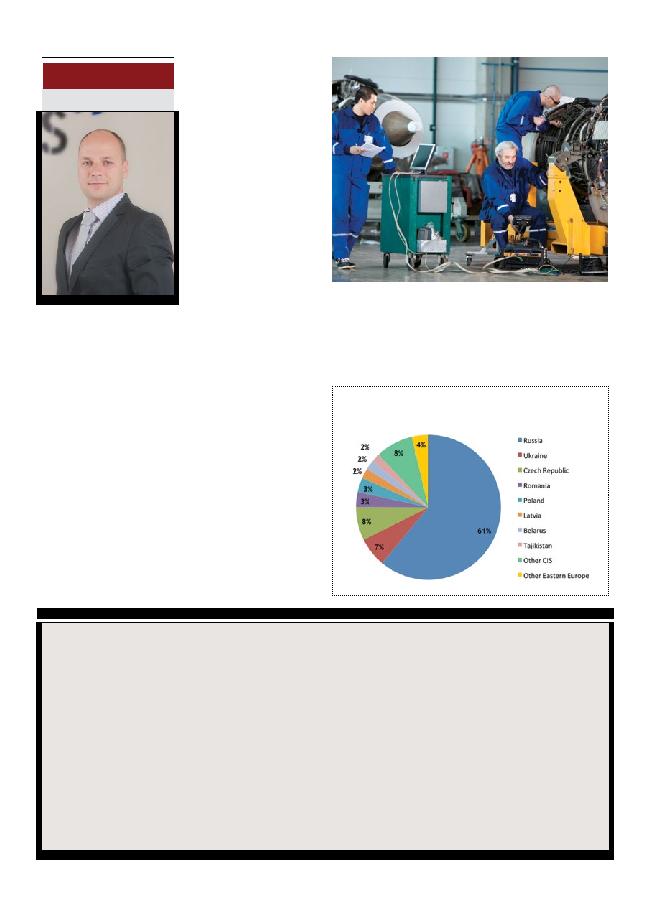
30
GA
/ Vol. 5 / No.9 / SEPTEMBER 2013
By Kestutis Volungevicius
Head of FL Technics
Industry News
CFM56 Family
success triggers
the demand
for training in
Eastern Europe
and the CIS
During the Jubilee Paris air show
Boeing and Ryanair finalised an
order for 175 Boeing 737-800
airplanes powered by CFM56-
7B engines worth $3.7 billion.
Meanwhile, last year the Russian
national carrier - Aeroflot also
announced the plans to introduce
around 50 Boeing 737 NG to
its fleet. These figures indicate
a steadily growing demand for
the CFM56 family engines as
airlines around the world are
Table 1. CFM56 Family engine fleet distribution in
Eastern Europe, the Baltics and the CIS
renewing their fleets thus
building the need for relevant
engine specialists, particularly
in Eastern Europe and the CIS.
CFM56 family remains one
of the most popular engine types
both globally and regionally.
For instance, approx.1240
CFM56 engines are being
operated in Eastern Europe,
Russia and the CIS. Moreover,
these engines correspond to
about 94-95% of the entire
narrowbody aircraft fleet in the
Baltics and the CIS. The figures
clearly indicate that in the
near future the CFM56 engine
market in the region should
show no signs of shrinking.
While the regional engine
market is being dominated by
the CFM engine family, local
demand for a particular engine
version within the family is
changing. It is estimated that
in the nearest future Russian
carriers alone will acquire
about 1700 new narrow-body
aircraft. Being in their second
fleet renewal round already,
Russian airlines are not only
further phasing out their Soviet-
era machines, but also shifting
towards newer generation
aircraft, like Boeing 737 NG. It
indicates that while the demand
for CFM56-3 series maintenance
services remains high, in a few
years time the market might
slowly start shrinking, giving
place to newer CFM56-7 series
for B737 NGs. Moreover, we
are highly likely to observe a
faster development process with
regard to CFM56-5B engines,
powering Airbus A320s.
`Aiming to support
manufacturers and their new
generation aircraft, CFM has
designed a number of even more
sophisticated solutions for better
engine performance. Newer engines
help to lower maintenance costs by
up to 4%. Meanwhile, the regional
demand for relevant specialists and
their training will remain quite high,
as many local operators and MROs
are further investing in both inventory
and technical personnel, required
to support day-to-day operation of
the renewed fleet. We anticipate that
in the upcoming several years the
demand will grow not only for the
CFM56 Engine Training, but also
for the more advanced programs,
first and foremost those which
focus on the NDT inspections. ·
Industria de Turbo Propulsores, S.A.
(ITP), and Rolls-Royce Plc have signed
an agreement by which ITP will be
responsible for the supply of Low Pressure
Turbines (LPT) for two new engines:
the Trent XWB-97 for the Airbus
A350-1000 and the Trent 1000-TEN for
all versions of the Boeing 787. This
contract will generate sales for ITP of 4
million euros in the next 30 years.
Ignacio Mataix, Chief Executive Officer of
ITP said " These contracts are a very important
step in the ITP strategic plan which includes
doubling ITPīs sales in the 2011-2015 period, as
well as continuing to provide Rolls-Royce with
Low Pressure Turbines for engines powering
twin aisle commercial aircraft. For ITP this
confirms a continuation in the growth path, as
well as continuation of investments in leading
programmes with high technological content."
In both agreements ITP will participate
as a Risk and Revenue Sharing Partner for
the life of the programs, hence extending
ITPīs participation to the complete family of
Rolls-Royce engines for twin aisle commercial
aircraft. Once the new aircraft enter service ITP
estimates to have a 50% share in the worldwide
market of LPTs for twin aisle aircraft.
ITP will be responsible for the Design,
Manufacture and Assembly of the Low
Pressure Turbine module for both engines.
The Low Pressure Turbine Module is one
of the main engine modules in modern large
turbofans. ITP will perform the complete
design of the turbines, including all phases
of the design, from conceptual design, to
detail design and development utilizing
the latest technology In order to produce
the cleanest and most efficient turbines.
ITP will manufacture all the key
components of the turbines in the facilities
of the ITP Group utilizing the latest
manufacturing technologies and will perform
the module assembly in order to supply a
complete assembled module to Rolls- Royce,
ready to be installed in the engines.
These new programs will generate
additional growth in ITP and will require
investments in excess of 250 million euro
in Research and Development, as well as in
industrial facilities to produce the turbines. ·
TRENT ACTION

